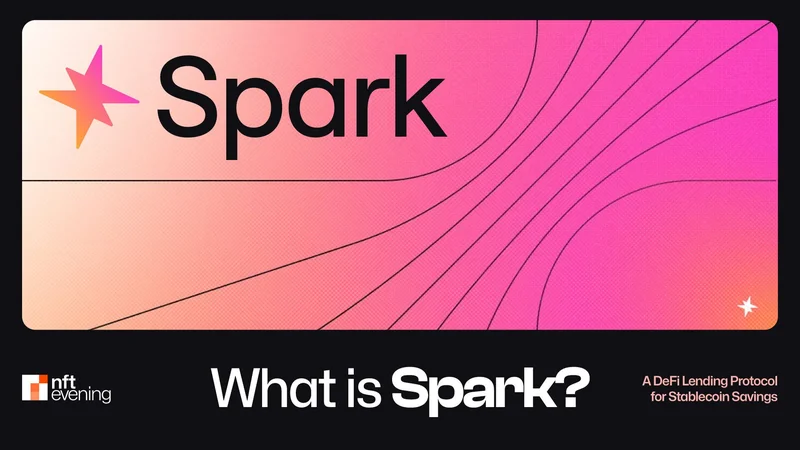This guide will walk you through Spark Protocol — an innovative platform designed to tackle the long-standing issue of fragmented liquidity in the DeFi space. You'll learn how to earn yield, borrow assets, and participate in liquidity mining through Spark.

Deep Dive into Spark Protocol: Definition, Vision, and Advantages
Spark Protocol was created to address key inefficiencies in DeFi: fragmented liquidity, volatile yields, and underutilized stablecoins. It accomplishes this by borrowing from Sky’s massive stablecoin reserves and deploying capital into DeFi, CeFi, and real-world assets (RWAs). Acting as a bilateral capital allocator, Spark provides users with seamless, on-chain, programmable yield opportunities while powering liquidity and yield infrastructure for other protocols.
Spark’s Three Core Products at a Glance
Spark Protocol offers three primary product categories:
- Savings: Earn yield simply by holding stablecoins.
- Borrow: A USDS-centric money market protocol.
- Liquidity Layer: Direct liquidity provisioning into DeFi markets.
Why Choose Spark Protocol? Addressing DeFi’s Core Pain Points
Spark was purpose-built to solve the following systemic problems in DeFi:
- Fragmented Liquidity: Liquidity is scattered across protocols, resulting in inefficiencies.
- Unstable Yields: Volatile returns make long-term yield strategies difficult to maintain.
- Idle Stablecoins: Large volumes of stablecoins remain underutilized.
By aggregating Sky's reserves and deploying them strategically, Spark maximizes capital efficiency across the ecosystem.
What Makes Spark Unique? A Comparison with Traditional DeFi Protocols
Compared to conventional DeFi protocols, Spark offers key advantages:
- Deep Liquidity: Backed by Sky’s stablecoin reserves, Spark ensures robust liquidity.
- Diversified Yield: By leveraging DeFi, CeFi, and RWAs, Spark provides risk-adjusted returns.
- Streamlined User Experience: Complex strategies are simplified into accessible products like sUSDS and sUSDC.
Getting Started with Spark Protocol: Step-by-Step Guide
Connect Your Wallet: Visit Spark Protocol’s official website and connect your MetaMask or WalletConnect wallet. Ensure you have enough stablecoins (USDS, USDC, etc.) for gas and investment.
Pro Tip: Always verify the official website URL to avoid phishing scams.
- Choose a Savings Product: Navigate to the “Savings” section and select a product like sUSDS or sUSDC.
Deposit Stablecoins: Choose the stablecoin you want to deposit, enter the amount, and approve the transaction in your wallet.
Note: Different stablecoins offer different yield rates. Pick based on your risk tolerance.
Start Earning: Once deposited, your stablecoins will immediately start earning yield, which is auto-compounded into your balance.
Common Issue: If you don’t see yield accumulation, verify that your transaction was confirmed.
Spark Borrow: A Strategy Guide for Borrowing with USDS
Spark Borrow enables users to supply USDS as collateral and borrow other crypto assets.
- Deposit USDS: On the “Borrow” page, deposit USDS to be used as collateral. Spark will show your borrowing limit based on your collateral.
- Choose an Asset to Borrow: Select an asset such as ETH or WBTC to borrow.
Confirm Borrowing: Enter the amount and confirm the transaction.
Risk Warning: Keep an eye on your collateral ratio to avoid liquidation.
Spark Liquidity Layer: Strategies for DeFi Liquidity Mining
Spark’s liquidity layer enables users to provide liquidity directly into DeFi markets and earn mining rewards.
- Choose a Liquidity Pool: Pick a liquidity pool based on your strategy.
- Provide Liquidity: Deposit the necessary stablecoins into the pool.
Earn Rewards: Once added, you’ll start earning liquidity mining rewards.
Pro Tip: Study each pool’s risks and expected returns before committing capital.
Risk Management in Spark Protocol: Safety Comes First
DeFi investments carry risk. Key risks include:
- Smart Contract Vulnerabilities: Bugs or exploits in protocol contracts.
- Collateral Liquidation: Sharp asset price drops can trigger liquidation.
- Market Volatility: The DeFi market is inherently unstable.
To mitigate risks:
- Do Your Own Research: Understand how Spark works and what risks it entails.
- Diversify: Don’t allocate all your capital to a single protocol.
- Set Stop-Loss Triggers: Limit downside exposure.
- Monitor Actively: Regularly check your portfolio and collateral ratios.
Best Practices to Maximize Your Spark Protocol Yield
- Leverage Spark’s Composability: Combine Spark with other DeFi strategies for optimal returns.
- Rebalance Regularly: Adjust your portfolio based on market conditions.
- Monitor Gas Fees: Time your transactions when fees are low.
Cost Breakdown: What Are the Fees When Using Spark?
| Fee Type | Description |
|---|---|
| Gas Fees | Required to execute transactions on the Ethereum blockchain |
| Borrowing Interest | Interest paid on borrowed assets |
| Liquidation Penalty | Fees incurred if your collateral is liquidated |
| Withdrawal Fees | Applicable fees when withdrawing from Spark Protocol |
Spark Protocol Security Checklist
- Verify the Official Site: Always ensure you’re on the correct website.
- Use a Hardware Wallet: Store your private keys offline.
- Enable 2FA: Activate two-factor authentication on all exchange accounts.
- Review Transactions Frequently: Spot any suspicious activity early.
- Understand Contract Risks: Familiarize yourself with the underlying smart contracts.
Troubleshooting Guide
- Transaction Failed: Check if your gas limit is set appropriately.
- No Yield Accrued: Ensure your transaction was confirmed and the funds are in the pool.
- Wallet Not Connecting: Make sure your wallet is on the correct blockchain network.
Future Outlook for Spark Protocol
Spark Protocol has the potential to become a cornerstone in the DeFi ecosystem. As the market matures, Spark’s role in boosting stablecoin utilization, enhancing liquidity, and offering programmable yields will only grow in significance.
Final Thoughts: Embrace Spark and Unlock the Next Era of DeFi
Spark Protocol offers a comprehensive solution to long-standing DeFi challenges. With its three key products, Spark empowers users to earn, borrow, and mine with efficiency, reliability, and ease.
FAQ
Q: How is Spark Protocol different from Aave or Compound?
A: Spark leverages Sky’s liquidity reserves to provide deeper and more efficient liquidity. Rather than competing directly, Spark aims to supply foundational liquidity infrastructure to other DeFi protocols.
Q: What’s the difference between sUSDS and sUSDC? Which should I choose?
A: Both are yield-bearing stablecoin products on Spark. sUSDC is generally seen as more stable due to Circle’s backing, while sUSDS may include a diversified basket of stablecoins. Your choice depends on your risk profile.
Q: Is Spark Protocol sustainable long-term?
A: Spark’s sustainability depends on responsible risk management, the continuous support of Sky’s capital, high-yield deployment strategies, strong governance, and active community engagement.
Related Articles

What is SparkLend? A Beginner-to-Advanced Guide to Decentralized Lending Made Easy
SparkLend is a decentralized, non-custodial liquidity market protocol built on the Ethereum blockchain. Simply put, it functions like a bank without intermediaries, allowing users to borrow and lend d
June 26, 2025
What is sUSDS? How Do I Acquire sUSDS?
This guide will walk you through Sky Savings’ sUSDS and sUSDC—your gateway to earning yield with stablecoins while keeping your funds secure.Sky Savings: Your Journey to Stablecoin Yields Begins HereW
June 26, 2025
What is SparkLend? A Complete Guide from Beginner to Pro
SparkLend is a decentralized, non-custodial liquidity market protocol that allows users to participate as lenders or borrowers. Lenders provide liquidity to earn passive income, while borrowers can ta
June 24, 2025
